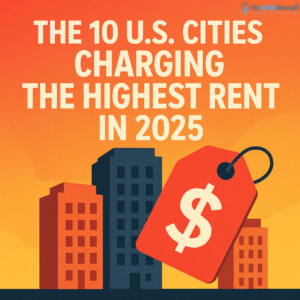If you’re feeling sticker shock while apartment hunting in 2025, you’re not alone. A new study by Storage Sense, recently highlighted by Sunset Magazine, reveals that rent prices have reached jaw-dropping levels in many U.S. metros—particularly along the West Coast and in the Northeast. The study looked at rental cost per 100 square feet, a metric that paints a clearer picture of just how much renters are paying for space, or in many cases, the lack of it.
Whether you’re a renter plotting your next move or a property manager assessing the competitive landscape, these numbers are essential reading.
Top 10 Cities by Rent per 100 Square Feet
| Rank | Metro Area | Rent per 100 sq ft |
|---|---|---|
| 1 | Washington, D.C. | $229.29 |
| 2 | San Francisco, CA | $225.94 |
| 3 | New York, NY | $190.47 |
| 4 | Boston, MA | $176.66 |
| 5 | San Jose, CA | $152.34 |
| 6 | San Diego, CA | $132.92 |
| 7 | Seattle, WA | $128.42 |
| 8 | Los Angeles, CA | $119.37 |
| 9 | Chicago, IL | $109.64 |
| 10 | Philadelphia, PA | $95.30 |
What stands out? California alone has four cities on the list, showing how concentrated high rents are in the West. But D.C. takes the top spot, proving that the East Coast isn’t exactly cheap either.
Why These Cities?
1. Washington, D.C.
As the nation’s capital, Washington, D.C. offers prestige, proximity to government jobs, and a robust metro system—but those perks come at a steep cost. With a rate of $229.29 per 100 sq ft, D.C. surpasses even San Francisco, reflecting ongoing housing shortages and sustained demand from professionals.
2. San Francisco, CA
A perennial contender for most expensive housing, San Francisco’s limited land availability and strict zoning laws continue to drive prices. At $225.94 per 100 sq ft, renters are often paying top dollar for extremely compact units.
3. New York, NY
New York’s legacy as a cultural and financial hub keeps demand high. At nearly $190 per 100 sq ft, renters are sacrificing space for access to jobs, culture, and a 24/7 lifestyle.
4. Boston, MA
Home to several top universities and a booming biotech sector, Boston’s price of $176.66 per 100 sq ft reflects its dense, high-demand rental market.
5. San Jose, CA
As the heart of Silicon Valley, San Jose’s high-tech workforce fuels steep housing costs. At over $152, the price per 100 sq ft is high, but so are the average incomes—creating a tricky dynamic for middle- and lower-income renters.
What’s Driving These Prices?
Several key factors contribute to the rent inflation in these cities:
-
Limited Housing Inventory: In many metros, housing construction hasn’t kept up with population growth.
-
High Job Density: Urban cores with thriving tech, finance, and government sectors attract talent—but also tighten competition for housing.
-
Small Living Spaces: Particularly in West Coast markets like San Francisco and LA, units are smaller on average, raising the price per square foot.
-
Zoning & Regulation: Restrictive development policies in cities like San Francisco and Boston prevent new housing from entering the market at scale.
Navigating Rent in a High-Cost Market
Whether you’re already renting or planning to relocate, here are a few strategic tips:
1. Focus on Cost Per Square Foot
Instead of just looking at total rent, assess the value per square foot. Some units may look affordable at first glance but offer far less space for the money.
2. Look Beyond the Obvious
Cities like Seattle and Chicago still offer relative affordability compared to their coastal peers, without sacrificing access to culture and infrastructure.
3. Consider Commuter Cities
If you’re priced out of the core city, look for adjacent commuter hubs that offer lower rents and public transit options.
4. Roommate Living
In cities like NYC or SF, living with roommates is still one of the most effective ways to afford rent without sacrificing location.
Looking Ahead
Rent affordability will remain a hot-button issue in 2025 as wages struggle to keep up with rental inflation. While cities like D.C., SF, and NY continue to see pressure due to job magnetism and housing scarcity, it’s possible we’ll see increased migration to second-tier cities as remote work persists.
For renters, that means staying informed, being flexible, and weighing value over prestige. For property managers and landlords, it’s a call to remain competitive—not just on rent, but on unit quality, amenities, and lease incentives.
Source: These 10 Cities Have the Highest Rent in the Country—and Half Are out West – Sunset Magazine

